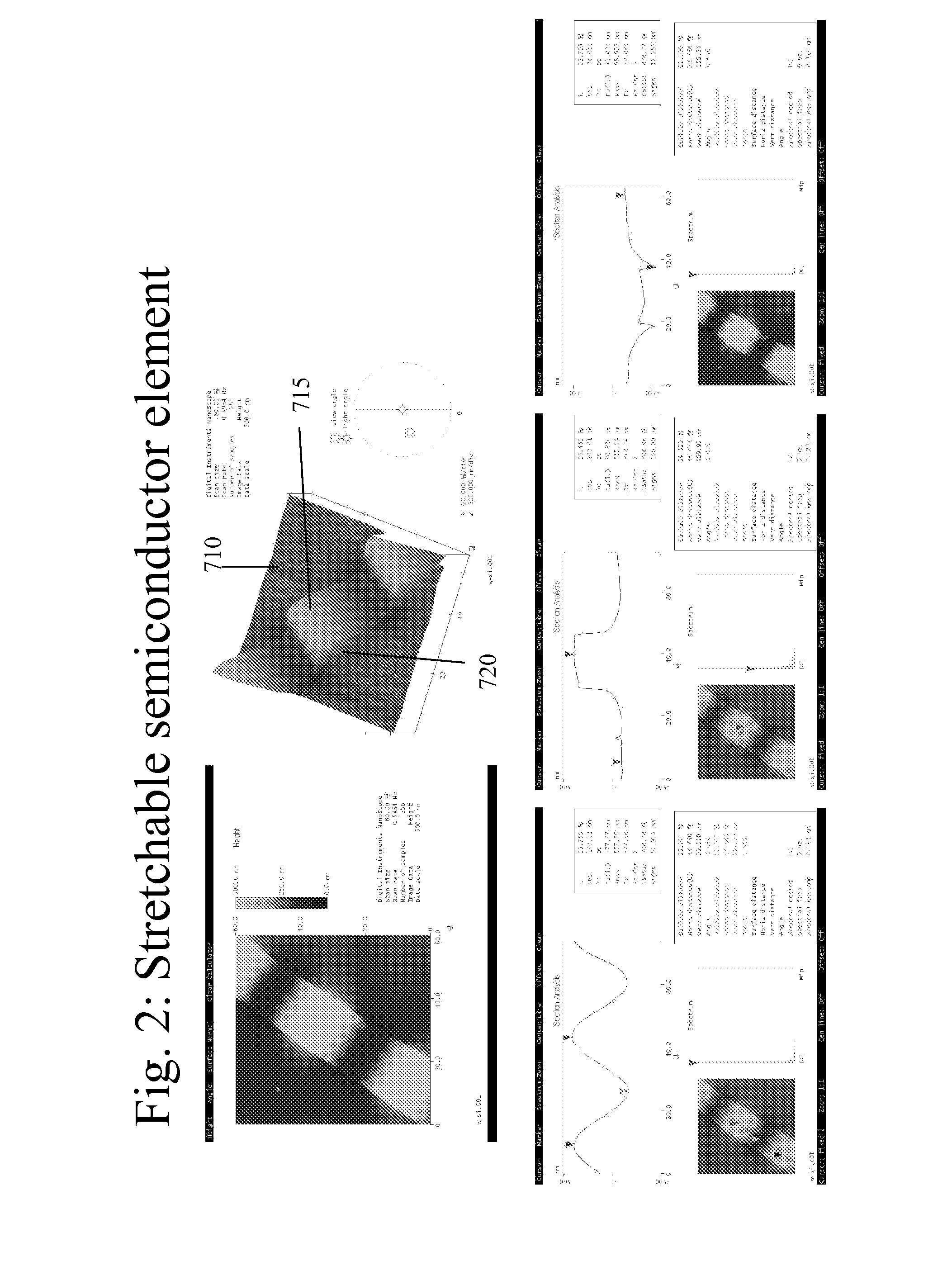Stretchable form of single crystal silicon for high performance electronics on rubber substrates
a technology of electronics and single crystal silicon, which is applied in the direction of final product manufacturing, sustainable manufacturing/processing, and semiconductor/solid-state device details. it can solve the problems of inability to bind to most plastic materials, inability to bind to most inorganic semiconductors in convenient solvents, and well-developed methods of making conventional silicon-based electronic devices. exhibiting good electronic performance, the effect of significant elongation, bending and flexing
- Summary
- Abstract
- Description
- Claims
- Application Information
AI Technical Summary
Benefits of technology
Problems solved by technology
Method used
Image
Examples
example 1
A Stretchable Form of Single Crystal Silicon for High Performance Electronics on Rubber Substrates
[0115]We have produced a stretchable form of silicon that consists of sub-micrometer single crystal elements structured into shapes with microscale periodic, wave-like geometries. When supported by an elastomeric substrate, this ‘wavy’ silicon can be reversibly stretched and compressed to large strains without damaging the silicon. The amplitudes and periods of the waves change to accommodate these deformations, thereby avoiding significant strains in the silicon itself. Dielectrics, patterns of dopants, electrodes and other elements directly integrated with the silicon yield fully formed, high performance ‘wavy’ metal oxide semiconductor field effect transistors, pn diodes and other devices for electronic circuits that can be stretched or compressed to similarly large levels of strain.
[0116]Progress in electronics is driven mainly by efforts to increase circuit operating speeds and int...
example 2
Buckled and Wavy Ribbons of GaAs for High-Performance Electronics on Elastomeric Substrates
[0145]Single crystalline GaAs ribbons with thicknesses in the submicron range and well-defined, ‘wavy’ and / or ‘buckled’ geometries are fabricated. The resulting structures, on the surface of or embedded in an elastomeric substrate, exhibit reversible stretchability and compressibility to strains >10%, more than ten times larger than that of GaAs itself. By integrating ohmic and Schottky contacts on these structured GaAs ribbons, high-performance stretchable electronic devices (e.g., metal-semiconductor field-effect transistors) can be achieved. This kind of electronic system can be used alone or in combination with similarly designed silicon, dielectric and / or metal materials to form circuits for applications that demand high frequency operation together with stretchability, extreme flexibility or ability to conform to surfaces with complex curvilinear shapes.
[0146]Performance capabilities in ...
example 3
Two-Dimensional Stretchable Semiconductors
[0158]The present invention provides stretchable semiconductors and stretchable electronic devices capable of stretching, compressing and / or flexing in more than one direction, including directions oriented orthogonal to each other. Stretchable semiconductors and stretchable electronic devices of this aspect of the present invention exhibit good mechanical and electronic properties and / or device performance when stretched and / or compressed in more than one direction.
[0159]FIGS. 27A-C provides images at different degrees of magnification of a stretchable silicon semiconductor of the present invention exhibiting stretchability in two dimensions. The stretchable semiconductor shown in FIGS. 27A-B was prepared by pre-straining an elastic substrate via thermal expansion.
[0160]FIGS. 28A-C provide images of three different structural conformations of stretchable semiconductors of the present invention exhibiting stretchability in two dimensions. As...
PUM
 Login to View More
Login to View More Abstract
Description
Claims
Application Information
 Login to View More
Login to View More - R&D
- Intellectual Property
- Life Sciences
- Materials
- Tech Scout
- Unparalleled Data Quality
- Higher Quality Content
- 60% Fewer Hallucinations
Browse by: Latest US Patents, China's latest patents, Technical Efficacy Thesaurus, Application Domain, Technology Topic, Popular Technical Reports.
© 2025 PatSnap. All rights reserved.Legal|Privacy policy|Modern Slavery Act Transparency Statement|Sitemap|About US| Contact US: help@patsnap.com



